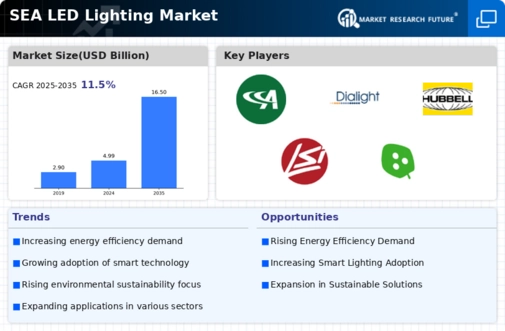Growing Demand for Energy Efficiency
The Global SEA LED Lighting Market Industry experiences a robust demand for energy-efficient lighting solutions. Governments and organizations worldwide are increasingly prioritizing sustainability, leading to a shift from traditional lighting to LED technology. This transition is driven by the need to reduce energy consumption and lower greenhouse gas emissions. In 2024, the market is projected to reach 4.99 USD Billion, reflecting a growing awareness of energy efficiency. The adoption of LED lighting is expected to contribute significantly to energy savings, as LEDs consume up to 75 percent less energy than incandescent bulbs, thereby enhancing the overall appeal of the Global SEA LED Lighting Market Industry.
Government Initiatives and Regulations
Government initiatives play a pivotal role in shaping the Global SEA LED Lighting Market Industry. Numerous countries are implementing stringent regulations to phase out inefficient lighting technologies and promote the adoption of LEDs. For instance, various nations have introduced financial incentives and rebates for consumers who switch to LED lighting. Such policies not only encourage the adoption of energy-efficient solutions but also stimulate market growth. As a result, the Global SEA LED Lighting Market Industry is likely to witness a surge in demand, with projections indicating a market value of 16.5 USD Billion by 2035, driven by these regulatory frameworks.
Technological Advancements in LED Technology
Technological advancements are significantly influencing the Global SEA LED Lighting Market Industry. Innovations in LED technology, such as improved lumens per watt and enhanced color rendering capabilities, are making LEDs more appealing to consumers and businesses alike. These advancements are not only enhancing the performance of LED lighting but also reducing production costs, thereby making them more accessible. As a result, the market is expected to grow at a compound annual growth rate of 11.5 percent from 2025 to 2035. This growth trajectory indicates a strong potential for the Global SEA LED Lighting Market Industry as technology continues to evolve and improve.
Increasing Urbanization and Infrastructure Development
Urbanization and infrastructure development are driving forces behind the Global SEA LED Lighting Market Industry. As cities expand and populations grow, there is a heightened demand for effective lighting solutions in urban areas. LED lighting is increasingly being adopted in street lighting, public spaces, and commercial buildings due to its energy efficiency and longevity. This trend is particularly evident in developing regions, where rapid urbanization necessitates sustainable lighting solutions. The Global SEA LED Lighting Market Industry is poised to benefit from this trend, as urban areas seek to enhance their infrastructure while minimizing energy costs.
Consumer Awareness and Preference for Sustainable Products
Consumer awareness regarding sustainability is reshaping the Global SEA LED Lighting Market Industry. As individuals become more environmentally conscious, there is a growing preference for products that align with sustainable practices. This shift in consumer behavior is driving the demand for LED lighting, which is perceived as a greener alternative to traditional lighting options. The emphasis on sustainability is prompting manufacturers to innovate and produce more eco-friendly lighting solutions. Consequently, the Global SEA LED Lighting Market Industry is likely to experience increased sales and market penetration as consumers actively seek out energy-efficient and sustainable lighting products.















Leave a Comment